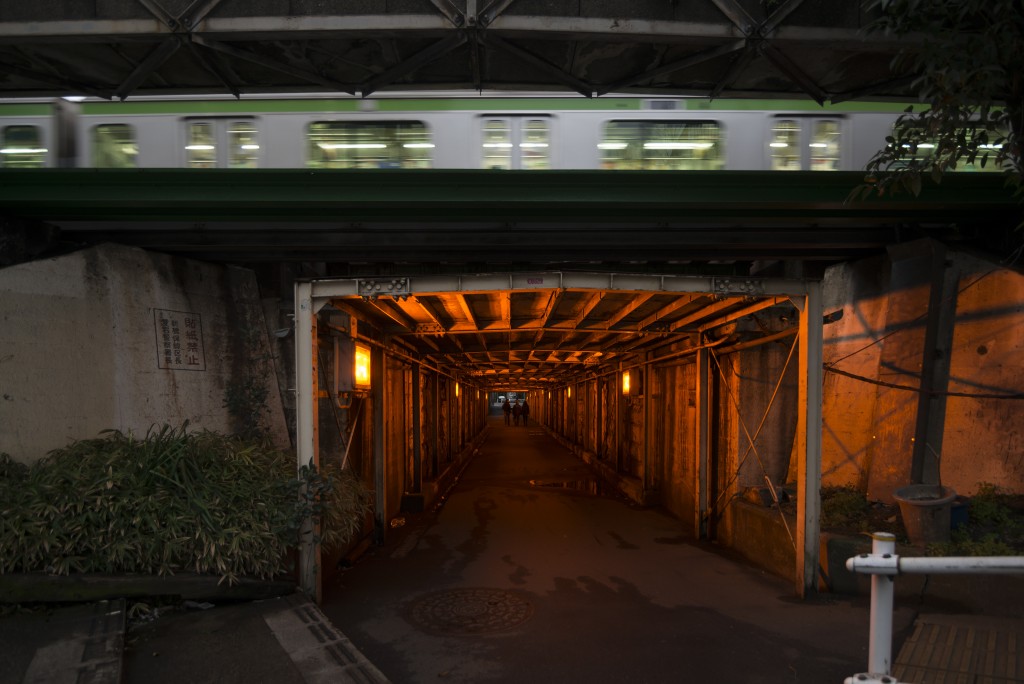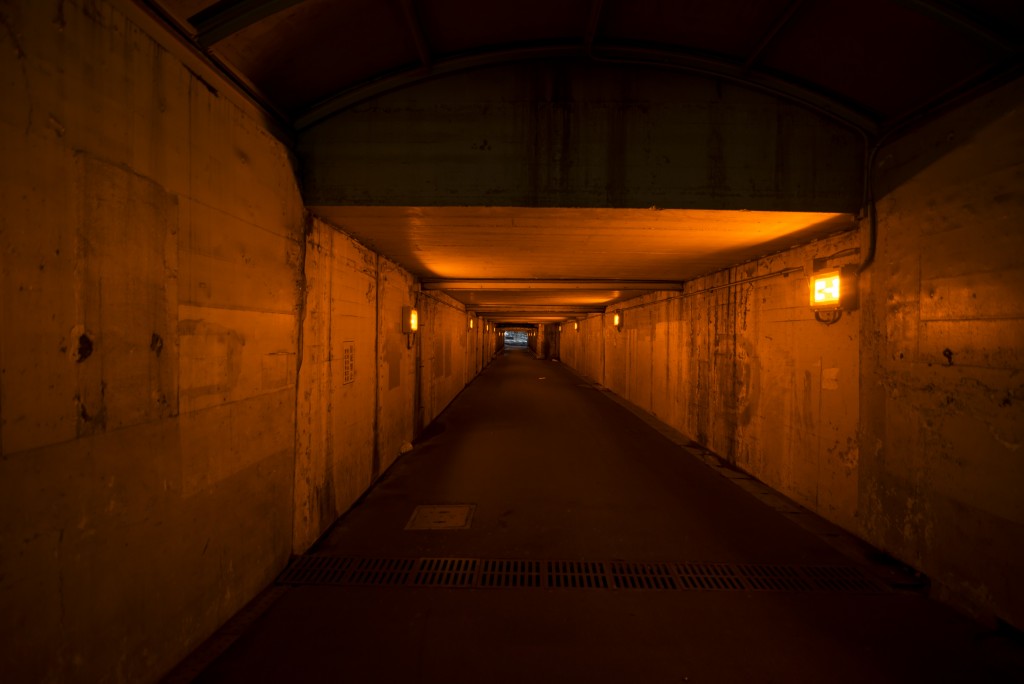
ムーニー・スザンヌ
Mooney Suzanne
移動 / 都市 / 風景
全ての都市に、文化、歴史、そして特徴があります。馴染みの都市で、私たちは小道や通りを抜け、公共機関の交通網や、決められた道を使って、住居だけでなく、商業ビルや公共の建物の間を移動します。しかし、どれほど頻繁にそのルートから外れることがあるでしょうか?いつものルートの裏側、下、上、間や内側には何があるのでしょう。このレポートシリーズでは、私たちはどのようにある地点から別の地点まで移動しているのか、都市の壁の存在と、それを超えるもの、さらに、注目をされていない空間が、どのようにアートと交流の場として再利用されるようになったのかということについて考えます。
01 場所から場所へ移動する / As We Travel from Point to Point
Warning: Use of undefined constant - assumed ' ' (this will throw an Error in a future version of PHP) in /home/users/2/abi0707/web/a-b-i.info/wp/wp-content/themes/abi/single-story.php on line 49

東京に住む私は、日々移動することに2時間以上を費やしています。人によって、日常の通勤・通学がそれより短い場合もありますが、私の平均時間は東京の基準と比較して、特に長いというわけではありません。私は乗り換えに一番便利な車両に乗り、一番効率的なルートで移動できるようにタイミングを測ります。ある駅から入場して、別の駅から出て、住む街を移動していますが、その景観は私から切り離されています。私は移動しますが、旅行者というわけではありません。移動したことによって、その場所に関する知識を得ているわけではないのです。社会人類学者のティム・インゴルド(Tim Ingold)※1は、そのような移動をウェイフェアリング(徒歩移動)と対比して、デスティネーション・オリエンティッド(目的地重視)の移動と呼んでいます。ここ数十年、住人、通勤・通学者、そして世界中の旅行者は、そのような方法で移動する傾向があります。その決められたルートの移動は、一時的に移動者を世界から切り離すため、移動によって彼らに変化が起こるということはありません。※2
日常では、通い慣れた道の代わりに、どの道を選択しようと考えることはないかもしれません。しかしながら、最近はブログを中心に、世界中の都市を探索する動きが見られます。探索者たちは、新しい道を見つけるという明確な目的を持ち、街を再発見し、都市景観を通して独自のルートを作り出しています。彼らは、フラヌール(遊歩者)※3とは異なり、都市生活に関する政治やイデオロギー─空間を取り戻すこと、に動機づけられています。その活動には、蛇行することや、とりとめのない散歩をもたらす、ウェイフェアリング(徒歩移動)、都市の決められた空間を通って新しい道を構想することも含まれています。東京では、”本当の”都市の探索を行うための、多くの外国人を含む組織的、そして即興的なグループ活動が見られます。その中の一つが、 Boat People Association(ボート・ピープル・アソシエイション)で、東京と横浜の水路を小さなボートや船で探索する活動をしています。他には、山手線(東京中心部のJR環状線)を周回するという活動があります。駅の間や地域を探索することを目的として、34.5kmの山手線を徒歩で周回することは、どの29駅からでも始めたり、終わらせたりすることができます。最近は、特に東京に住む外国人の間で、都市を探索する方法として、この歩行ルートが比較的人気を呼んでいます。私は日々の生活の多くを空間と空間の間、場所と場所の間で過ごしているため、今年は是非、山手線を徒歩で周回したいと思っています。
※1 ティム・インゴルド イギリスの文化人類学者。アバディーン大学教授。
※2 参考資料「ラインズ 線の文化史」(ティム・インゴルド著、工藤晋訳 左右社 2014年)
※3 フランス語で「(都市生活をおくる)遊歩者(彷徨者)」の意味。
(日本語訳協力:Ayami Mori)
日常では、通い慣れた道の代わりに、どの道を選択しようと考えることはないかもしれません。しかしながら、最近はブログを中心に、世界中の都市を探索する動きが見られます。探索者たちは、新しい道を見つけるという明確な目的を持ち、街を再発見し、都市景観を通して独自のルートを作り出しています。彼らは、フラヌール(遊歩者)※3とは異なり、都市生活に関する政治やイデオロギー─空間を取り戻すこと、に動機づけられています。その活動には、蛇行することや、とりとめのない散歩をもたらす、ウェイフェアリング(徒歩移動)、都市の決められた空間を通って新しい道を構想することも含まれています。東京では、”本当の”都市の探索を行うための、多くの外国人を含む組織的、そして即興的なグループ活動が見られます。その中の一つが、 Boat People Association(ボート・ピープル・アソシエイション)で、東京と横浜の水路を小さなボートや船で探索する活動をしています。他には、山手線(東京中心部のJR環状線)を周回するという活動があります。駅の間や地域を探索することを目的として、34.5kmの山手線を徒歩で周回することは、どの29駅からでも始めたり、終わらせたりすることができます。最近は、特に東京に住む外国人の間で、都市を探索する方法として、この歩行ルートが比較的人気を呼んでいます。私は日々の生活の多くを空間と空間の間、場所と場所の間で過ごしているため、今年は是非、山手線を徒歩で周回したいと思っています。
※1 ティム・インゴルド イギリスの文化人類学者。アバディーン大学教授。
※2 参考資料「ラインズ 線の文化史」(ティム・インゴルド著、工藤晋訳 左右社 2014年)
※3 フランス語で「(都市生活をおくる)遊歩者(彷徨者)」の意味。
(日本語訳協力:Ayami Mori)
As We Travel from Point to Point
Living in Tokyo, on an average day, I spend more than two hours travelling across the city. Although for some the daily commute is a little less, my daily average is certainly not especially high by Tokyo standards. I enter the train car that I know will leave me at the right exit to make the quickest transfer, timing to the minute the most efficient route. Entering at one station and departing at another, my journey takes me across this city I inhabit, but also removes me from its landscape. I travel, but I am not a traveller. I gain no knowledge of the spaces I traverse. Social anthropologist Tim Ingold ※1 refers to such journeying as destination-oriented travel, as opposed to wayfaring. In recent decades, city dwellers, commuters, and holidaymakers throughout the globe tend to travel in this manner. Such travel from point to point along designated routes temporarily removes the traveller from the world, leaving them unchanged by the journey taken . ※2
On an ordinary day spent in the city we may forget to choose where to walk, taking instead the obvious, well-travelled, and easy path. However, there has been a recent trend, visible mostly through online blogs, of urban exploration in cities across the globe, which sees explorers set out with the explicit intention of finding a new path, to re-discover their city, and to make their own route through the urban landscape. Unlike the Flâneur※3 , urban explorers are often motivated by politics and ideologies relating to urban life—reclaiming spaces. Their actions do involve wayfaring, plotting new paths through the delineated spaces of the city, leading to a meandering and indeed an apparent flânerie of sorts. In Tokyo there have also been bouts of urban exploration through both organised and impromptu group activity. One such group is Boat People Association, which explores the waterways of Tokyo and Yokohama in small boats and vessels. Another mode of exploration is circumnavigation of the Yamanote Line (Central Tokyo’s JR circle line). This walk around the entire loop, with the aim of exploring the areas around and between the stations of the Yamanote, is a 34.5km walk that can be begun and completed at any of the twenty-nine stations on the Yamanote line. Recently, this walking route has become a relatively popular way to explore the city, particularly for foreigners living in Tokyo.Living a regular portion of my day in the in-between space between location and location, walking the Yamanote loop is on the top of my to-do list for this year.
※1 Tim Ingold, British anthropologist, and a professor at the University of Aberdeen.
※2 Lines: A Brief History, (London ; New York: Routledge, 2007).
※3 Walter Benjamin, “Paris: Capital of the Nineteenth Century,” Perspecta 12 (January 1, 1969): 165–72
Living in Tokyo, on an average day, I spend more than two hours travelling across the city. Although for some the daily commute is a little less, my daily average is certainly not especially high by Tokyo standards. I enter the train car that I know will leave me at the right exit to make the quickest transfer, timing to the minute the most efficient route. Entering at one station and departing at another, my journey takes me across this city I inhabit, but also removes me from its landscape. I travel, but I am not a traveller. I gain no knowledge of the spaces I traverse. Social anthropologist Tim Ingold ※1 refers to such journeying as destination-oriented travel, as opposed to wayfaring. In recent decades, city dwellers, commuters, and holidaymakers throughout the globe tend to travel in this manner. Such travel from point to point along designated routes temporarily removes the traveller from the world, leaving them unchanged by the journey taken . ※2
On an ordinary day spent in the city we may forget to choose where to walk, taking instead the obvious, well-travelled, and easy path. However, there has been a recent trend, visible mostly through online blogs, of urban exploration in cities across the globe, which sees explorers set out with the explicit intention of finding a new path, to re-discover their city, and to make their own route through the urban landscape. Unlike the Flâneur※3 , urban explorers are often motivated by politics and ideologies relating to urban life—reclaiming spaces. Their actions do involve wayfaring, plotting new paths through the delineated spaces of the city, leading to a meandering and indeed an apparent flânerie of sorts. In Tokyo there have also been bouts of urban exploration through both organised and impromptu group activity. One such group is Boat People Association, which explores the waterways of Tokyo and Yokohama in small boats and vessels. Another mode of exploration is circumnavigation of the Yamanote Line (Central Tokyo’s JR circle line). This walk around the entire loop, with the aim of exploring the areas around and between the stations of the Yamanote, is a 34.5km walk that can be begun and completed at any of the twenty-nine stations on the Yamanote line. Recently, this walking route has become a relatively popular way to explore the city, particularly for foreigners living in Tokyo.Living a regular portion of my day in the in-between space between location and location, walking the Yamanote loop is on the top of my to-do list for this year.
※1 Tim Ingold, British anthropologist, and a professor at the University of Aberdeen.
※2 Lines: A Brief History, (London ; New York: Routledge, 2007).
※3 Walter Benjamin, “Paris: Capital of the Nineteenth Century,” Perspecta 12 (January 1, 1969): 165–72


記事一覧
-
2020-summer-story
02│8月12日 台湾 -
2020-summer-story
01│8月5日 東京 -
2020-summer-story
00│公開予定 -
町田恵美
01│MAX PLAN 1970-1979 -
港千尋
02│瞬間建築 -
港千尋
01│長い橋 -
関川歩
01│南方以南 the Hidden South -
呂孟恂
00│プロフィール -
町田恵美
00│プロフィール -
関川歩
00│プロフィール -
港千尋
00│プロフィール -
瀬尾夏美
05│ふるさと -
ぬかつくるとこ
05│上木戸工作室 -
辻田美穂子
05│BRIDGE STORY05 -
辻田美穂子
04│BRIDGE STORY04 -
ぬかつくるとこ
04│コイケノオイケ -
瀬尾夏美
04│架空のまち|誰かに旅をしてもらう -
ぬかつくるとこ
03│しょうへいくんのプラバン工場 -
辻田美穂子
03│BRIDGE STORY3 -
瀬尾夏美
03│なくなったまちを訪ねて -
ぬかつくるとこ
02│とだのま -
辻田美穂子
02│BRIDGE STORY02 -
02│掘る形 -
瀬尾夏美
02│山の終戦を訪ねる -
キオ・グリフィス
01│文聞録~其の一 -
辻田美穂子
01│BRIDGE STORY01 -
ぬかつくるとこ
01│「ぬか つくるとこ」とは -
瀬尾夏美
01│陸前高田にて -
01│The Color of Oil -
瀬尾夏美
00│プロフィール -
00│プロフィール -
00│プロフィール -
キオ・グリフィス
00│プロフィール -
辻田美穂子
00│プロフィール -
ぬかつくるとこ
00│プロフィール -
ムーニー・スザンヌ
05│レジリエント・アーティスト -
齋藤彰英
05│《移動すること》構造線と塩の道 ⑤ -
大谷悠
05│現代都市のアジールと「あそび」のクオリティ -
大谷悠
04│都市の「あそび」に集まるひとたち——「日本の家」となかまたち -
舩木翔平
05│新しい日常を創り出すこと -
舩木翔平
04│野菜たちの作り方 -
原亜由美
05│記憶の居場所 -
仲宗根香織
05│小舟で漕いで行く -
太田エマ
04│#IAmaMigrant -
江上賢一郎
05│『流転しつつ根をはること -マレーシア、インドネシアの芸術・文化実践- 』 -
齋藤彰英
04│《移動すること》構造線と塩の道 ④ -
ムーニー・スザンヌ
04│猫の生活:下、上、間、後ろ、向こう -
太田エマ
03│70代以上の女性:どうやって働いてきたのでしょうか? -
江上賢一郎
04│都市の瓦礫から文化をつくる。(韓国) -
仲宗根香織
04│宇宙につながる歴史、光、写真 -
原亜由美
04│リトアニアとハワイ -
大谷悠
03│「公共空間」で「あそぶ」— 小倉城を攻め落とした話 -
ムーニー・スザンヌ
03│都市発展のオルタナティブ・タイムライン -
齋藤彰英
03│《移動すること》構造線と塩の道 ③ -
舩木翔平
03│畑の中の小さなお店から始まる出来事 -
江上賢一郎
03│台南の家族たち -
仲宗根香織
03│傷の想像力 -
原亜由美
03│照らされること -
ムーニー・スザンヌ
02│包含し、守り、分ける、壁 -
齋藤彰英
02│《移動すること》構造線と塩の道 ② -
大谷悠
02│産業遺産を「アート」で「あそぶ」— ドイツの衰退工業都市に「パラダイス」をつくった話 -
舩木翔平
02│街にヤギ -
太田エマ
02│アートとプレカリアート¹ -
原亜由美
02│土地と向き合う -
江上賢一郎
02│Alternative Asia 香港編(後編) -
仲宗根香織
02│生まれ変わる街を想像する力 -
齋藤彰英
01│《移動すること》構造線と塩の道 ① -
大谷悠
01│「空き家」と「あそび」— ライプツィヒ「日本の家」 -
舩木翔平
01│ニュータウンに残された奇跡の農村風景 -
ムーニー・スザンヌ
01│場所から場所へ移動する / As We Travel from Point to Point -
原亜由美
01│夏と記憶の欠片 -
太田エマ
01│パブリックと領域
場所を持つことはパブリックを不可能にするか? -
江上賢一郎
01│Alternative Asia 香港編(前編) -
仲宗根香織
01│秘密のない風景 -
ムーニー・スザンヌ
00│プロフィール -
舩木翔平
00│プロフィール -
大谷悠
00│プロフィール -
齋藤彰英
00│プロフィール -
仲宗根香織
00│プロフィール -
原亜由美
00│プロフィール -
太田エマ
00│プロフィール -
江上賢一郎
00│プロフィール
Warning: array_pop() expects parameter 1 to be array, bool given in /home/users/2/abi0707/web/a-b-i.info/wp/wp-content/themes/abi/sidebar.php on line 19
Warning: array_shift() expects parameter 1 to be array, bool given in /home/users/2/abi0707/web/a-b-i.info/wp/wp-content/themes/abi/sidebar.php on line 22
Warning: array_pop() expects parameter 1 to be array, bool given in /home/users/2/abi0707/web/a-b-i.info/wp/wp-content/themes/abi/sidebar.php on line 19
Warning: array_shift() expects parameter 1 to be array, bool given in /home/users/2/abi0707/web/a-b-i.info/wp/wp-content/themes/abi/sidebar.php on line 22
Warning: array_pop() expects parameter 1 to be array, bool given in /home/users/2/abi0707/web/a-b-i.info/wp/wp-content/themes/abi/sidebar.php on line 19
Warning: array_shift() expects parameter 1 to be array, bool given in /home/users/2/abi0707/web/a-b-i.info/wp/wp-content/themes/abi/sidebar.php on line 22
Warning: array_pop() expects parameter 1 to be array, bool given in /home/users/2/abi0707/web/a-b-i.info/wp/wp-content/themes/abi/sidebar.php on line 19
Warning: array_shift() expects parameter 1 to be array, bool given in /home/users/2/abi0707/web/a-b-i.info/wp/wp-content/themes/abi/sidebar.php on line 22